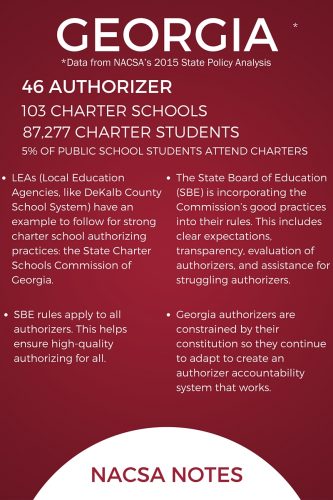In their own words |
What follows are edited excerpts of our Story Suite conversation with Gregg Stevens, Deputy Director and General Counsel, State Charter Schools Commission of Georgia.
NACSA: How long have you been in this position?
Gregg: I’ve been in this role for about two and a half years. We—the State Charter Schools Commission of Georgia—began in 2013. We got up and running with our executive director in March of 2013, and I was the first hire in April of 2013. Prior to that, I was with the Georgia Department of Education for eight or nine years in their legal services office.
NACSA: What made you make the change?
Gregg: You know, like a lot of attorneys, I’m willing to put a lot of what I want to do aside for the role, and for that goal of being a zealous advocate for your client. My client had always been education generally and, in education, my client is the student. But moving into the charter arena gave me more of a focus on who my client was and serving students.
Charter Schools in Prisons
NACSA: How do you get a sense about how what you’re doing impacts those students?
Gregg: When I go to the schools—specifically the schools that focus on at-risk students and those that have dropped out of school—I am able to see that these students are here because of what we do as the Commission. Otherwise, they might not be in school anymore; they might not have an opportunity to get a high school diploma. We recently approved a charter school that operates out of a couple prisons in Georgia. Going into those environments and seeing them serve prisoners who previously never had an opportunity to get a high school diploma and knowing that option is there makes me go in to work every day.
NACSA: It’s got to be powerful to see that happening in a prison.
Gregg: It’s very interesting. It’s unlike any other site visit. I mean, it’s a prison. But they’re able to be taught by real teachers. They get a high school education that’s high quality, and they’ll go back into society in a much better place than they would otherwise be.

NACSA: What do you think they were getting before?
Gregg: The Department of Corrections has had a longstanding effort of improving its educational programs and it has never really been the quality that it needed to be. Typically, most of the programs were focused on GEDs and then trade school opportunities. This particular program gives them the opportunity for that high school diploma and to move on into post secondary education, either within the prison system with the training opportunities and the post secondary options there or when they’re reintegrated into the society and are able to continue their education and be productive members of the community.
NACSA: Have you gotten a chance to talk to any inmates directly and what do you hear from them?
Gregg: It’s moving. Georgia is leading a national effort in prison reform. We’ve got a lot of good things going on through our governor, Nathan Deal, who is really pushing a comprehensive prison reform package. We’re seeing the conversation shift from being a retribution-based society (“You did something wrong and now you’re going to be punished for it”) to really recognizing that you made a mistake and here, let’s help you fix that and get back into society.
So you talk to these children, or adults in some cases, and you see them really verbalize and embody that forgiveness. They’re there and they say, “Yes. I made a mistake, but look at what I’m doing now. I’m moving past it. I regret what I’ve done, but I’m focused on the future and I’m going to be a great citizen of Georgia in the future.”
NACSA: …so these are young adults, in some cases, adults?
Gregg: Some teens, usually aging teens from 17-21. At 21, they’re no longer eligible for educational funding in Georgia, but again, these are opportunities that they wouldn’t have had without this charter school.
Serving At-Risk Youth
NACSA: What was your high school experience like?
Gregg: I grew up in metro Atlanta. I graduated from the largest high school east of the Mississippi, it was said. We had over 1,000 in our graduating class. I was involved in activities and lived a pretty traditional high school life, but you know, I think at the end of the day, I was just a number.
Seeing our high schools and our charter systems and working for at-risk youth, particularly in the prisons, and knowing that it’s a real school—it’s not a traditional high school environment, but there’s someone that those students matter to in those schools. The schools are there to serve the students and actually care about the children, which isn’t something that I had.
NACSA: The size obviously has to be a part of it, but was there other things too, in terms of the structure or the way that the relationships are supported?
Gregg: Absolutely. I think the size is conducive to having a more welcoming environment, but what you’ll see in these charter schools is genuine care and compassion for the students, and it’s hard to do that when you’re serving 150 students a day. But when you’ve got a couple dozen at-risk students who really need your help and support, everybody’s able to give that 110% to serve those kids.
Autonomous Schools
NACSA: What’s your motivation mantra? What keeps you going and keeps you connected to why you want to do this job?
Gregg: That’s a hard question. I think I’m mostly motivated by recognizing that I don’t have the answer. I don’t know what the best choice is at any given moment for a school, for a family, or for a student, but what I know is that I’m there to support the schools.
And so, because the schools are autonomous in the charter environment, they are able to hopefully make that right decision and to be able to guide the parent and the student to what they need to do.
It might not be perfect for everybody. But that’s why we have a portfolio and why we have that spectrum of school options: because nobody has THE answer. But maybe that student, that school, has a leg up on what the answer is for THAT environment. And so, what makes me motivated and what makes me continue is that I’m not going to be able to pick the right choice for those kids or for that school. But I can support them in the decisions that they do make and, hopefully, it’s the right decision.


